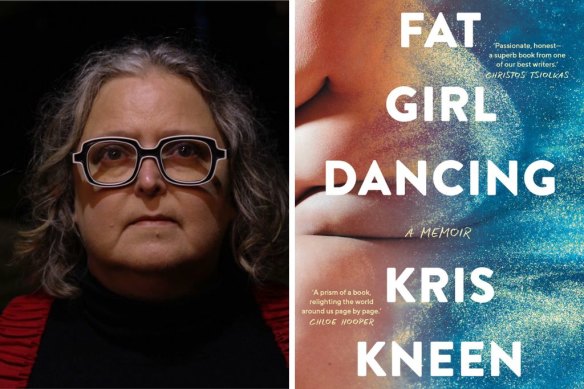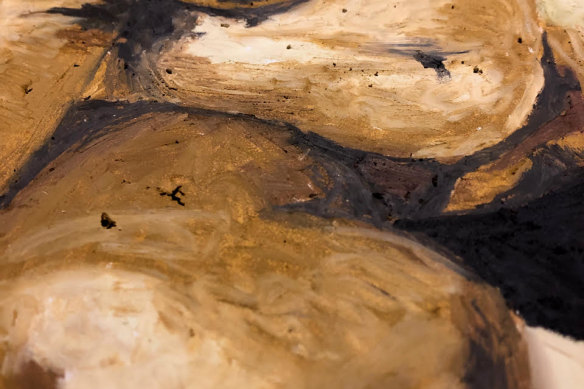By Sam van Zweden
MEMOIR
Fat Girl Dancing
Kris Kneen
Text, $34.99
Living in a bigger body can make looking and seeing your body with any sense of honesty and clear sightedness a deeply complex task. Looking in the mirror, we see some version of ourselves: reversed, with our focus on those parts that make us the most miserable. Biases layered over expectations, beauty ideals layered over fat phobia; it all comes to feel like an immovable Instagram filter. Remember the viral Zoom recording of a lawyer with a cat filter that perplexed him? “I’m not a cat!” he insisted, but we could all see.

Kris Kneen’s Fat Girl Dancing explores her battle to overcome the stereotypes.Credit:
Kris Kneen’s Fat Girl Dancing is a series of attempts by the author to really see themself. Living in a fat body means being confronted daily with social expectation and judgment, and Kneen details these violences. There’s the sidelong glances at meals chosen when eating in public, and the assumptions medical professionals make based on body size and shape. There’s the permission so many people still feel to make fun of fatness and of fat people, who Kneen suggests are “one of the last bastions of discrimination”: the butt of jokes, the target of bullying and public ridicule.
This narrative about fatness and these assumptions about bigger bodies add up to what North American writer Lindy West described as an “Alp of shame that crushes every fat person every day of their lives”. This is what Kneen is writing Fat Girl Dancing in the face of – and it’s a lot to see over.
A connected and positive sense of embodiment can feel near impossible for folks in bigger bodies, but Kneen tries anyway. Their dedication to throwing themself into a pursuit is commendable, and the crushing disappointment of that pursuit not being a good fit feels familiar – the world, with all its access barriers and judgments, doesn’t change under the force of enthusiasm.

One of Kneen’s self-portraits from Fat Girl Dancing.Credit: Anthony Mullins
Kneen swims naked in Tasmania, and is kidnapped as a “dugong princess” in Vanuatu. They try diving, complete with a custom wetsuit, and battle their natural buoyancy. They’re kitted out and determined to hike the Three Capes Track, but their quiet relief is palpable when COVID hits and they’re kept within state lines.
The body isn’t something they can simply step into and accept. In this, Kneen’s attitude reflects a larger view of body acceptance or neutrality that demands exceptionalism. Self-acceptance and body neutrality are good things, great things, that other people deserve. However, to want it for ourselves we must be exceptional. We will love ourselves when we have earned it.
Through it all, Kneen – not only a writer but also a longtime visual artist – draws themself. The book is punctuated with illustrations, first from a photo shoot of their abstracted fat body, and then with Kneen’s self-portrait sketches. This embodiment project has its own challenges – those of material, scale and perspective. It demands a clear view to see beyond expectation and bias to what’s really there.
The cover of Fat Girl Dancing also features a naked fat body – obscured enough that it becomes an object of fascination. Is that a breast or a butt cheek? If that’s an arm, is it thrown forward or backwards? Before even opening the book, the cover art is a challenge to deeply consider a fat body without judgment.
Kneen’s vulnerability has been a signature of their work for years. Their earlier memoirs, Affection and The Three Burials of Lotty Kneen, laid bare their relationship with sex and intimacy, and inheritance and intergenerational trauma respectively.
This same vulnerability carries into Fat Girl Dancing, having another run at memoir through a new lens. This isn’t rehashing old ground – there are chapters on sexuality, and recognisable experiences readers may know from those other books, but Kneen’s growth and experience show that as we continue to live we keep understanding things anew.
Kneen taps into research and theory, but lightly – the driving narrative here is of their journey of embodiment and self-acceptance. They are a sure and curious guide into the world of fat liberation, through a mixture of their own attempts at honest, full-fleshed body acceptance and an approach to research that discovers a new world of strong “weapons, or at least defences” in the fight against fatphobia, whether it’s spat from the mouths of strangers, delivered with authority by the biased medical establishment, or turned inward against ourselves.
Fat Girl Dancing provides further ammunition, helping build the Australian voice in this essential conversation about which bodies deserve respect and when – that is, all of them, and always.
Sam van Zweden is the author of Eating With My Mouth Open, published by NewSouth at $29.99.
The Booklist is a weekly newsletter for book lovers from books editor Jason Steger. Get it delivered every Friday.